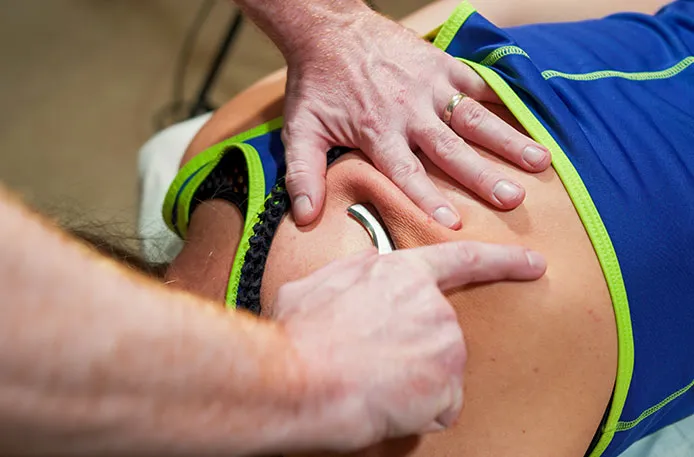Manual therapy is one of the most effective treatments for a wide range of joint and soft tissue dysfunction. We specialize in providing manual physical therapy, including spinal and joint mobilization, soft tissue mobilization, IASTM (similar to the Graston technique), muscle energy techniques, and fascial techniques to reduce pain and restore mobility.
What is Manual Therapy?
Manual therapy is a hands-on approach that engages dysfunctional tissue in a specific way to address pain and movement deficits. Without it is, typical exercise treatment has a minimal effect.

Typically, patients visit a physical therapist when they are experiencing pain with movement. During treatment, your physical therapist should use some form of manual therapy described below. Through this type of physical therapy, our highly-trained and experienced manual therapist is able to implement a hands-on approach to healing that is designed to help manage chronic pain, increase your range of motion, reduce inflammation, treat joint structures and promote faster healing. If you or a loved one is experiencing pain with movement, please contact our offices today to learn more about how manual therapy could be right for you.
Types of Manual Therapy Used
Joint Mobilization
One of the most common causes for pain in movement is dysfunction in the joints. Through joint mobilization, your physical therapist increases movement in stiff or hypomobile joints by applying pressure in the directions in which the joints are stiff. Your therapists can use joint mobilization to treat any joint in the body including the jaw, the spine, and the extremities. Joint mobilization techniques can range from gentle oscillation to high-velocity-low-amplitude techniques. Increased range of motion and decreased pain is expected after joint mobilization
Soft Tissue Mobilization
Another common cause for pain with movement is dysfunction in soft tissue such as muscles, tendons, ligaments, and fascia. With soft issue mobilization, your physical therapists uses their hands or an instrument to treat the dysfunction in order to increase range of motion and decrease pain. Some techniques include cross-fiber friction, trigger point release, Rolfing, and dry needling.
High Velocity, Low Amplitude
This is generally considered to be a more aggressive approach to manual therapy that is designed to relieve chronic pain and restore range of motion by bringing a joint to the restrictive barrier and thrusting it. This technique is usually called an adjustment by chiropractors but they are not the only practitioner that can perform them. The high velocity, low amplitude thrusting technique is ideal for restoring joint motion quickly. While considered to be a more aggressive form of physical therapy, this technique is still completely safe and pain-free.
Fascial Counterstrain
This is a highly specialized form of manual therapy that uses diagnostic tender points to identify reflexive and painful dysfunctions in the body. These tender points are associated with trapped inflammation that continuously irritates the tissue and causes pain and other various symptoms. This inflammation can be trapped in various fascial layers in all the different systems of the body, which can lead to muscular dysfunction, edema, organ dysfunction, neuropathies, and more. Fascial Counterstrain uses a gentle hands-on process using slackening or decompression of involved tissue to facilitate the release of inflammatory markers trapped in the body and alleviates reflexive tension, pain, muscular dysfunction, trigger points. Many patients report long-lasting relief of symptoms after a few sessions. This is one of the most powerful tools in your physical therapist’s arsenal to reduce pain improve function.
Muscle Energy Techniques (METs)
METs are another one of your therapists’ tools in his arsenal to reduce joint restriction and improve mobility all to alleviate your pain. Sometimes joints in the low back and pelvic area can be stuck positions that cause joint and muscle pain. Muscle energy techniques use the patient’s own muscles to reposition these joints to decrease pain.
How is Manual Therapy an Effective Part of Physical Therapy?
Before our physical therapist begins manual therapy treatment, a full assessment of your body mechanics, gait and movement is completed. From there, the best type of treatment to fit your individual needs will be implemented to achieve fast pain-relief. Manual therapy is ideal to help increase blood flow, reduce chronic pain, restore full range of motion and achieve an optimal level of overall wellness. This integral part of physical therapy treatment is safe, non-invasive and ideal for treating patients of all ages.
Our physical therapists are highly trained in diagnosing and treating movement disorders. These disorders often occur following surgery, however are an integral part of avoiding surgery in the first place. Although many physicians prescribe manual physical therapy, a physician’s order is never necessary to begin. Most people seek out physical therapy for injuries, accidents, or illnesses – essentially, anything that makes you feel weak and unable to function at your normal physical levels.
Your treatment plan will likely include several different forms of manual therapy, all aimed at helping a specific function of your body. Some treatment may focus on improving your pain, while others may focus on increasing your range of motion. Manual therapy is a crucial part of a treatment plan, as it helps to reduce pain and swelling, minimize inflammation, and increase range of motion.
See Our Manual Therapy Specialists
Within the scope of physical therapy practice, manual therapy is appropriate if the physical therapist has undergone adequate training in the techniques. If you think you could benefit from manual therapy, schedule an appointment with us today!
